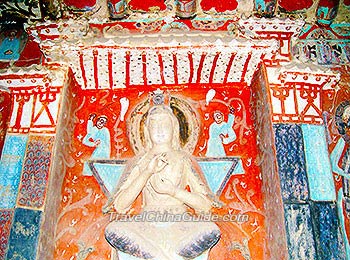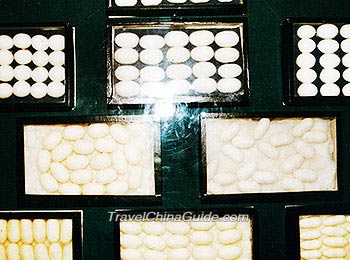Culture of Silk Road
The ancient Silk Road contributed greatly to the cultural exchange between China and the West. From the second century BC to the fifteenth century AD, splendid civilizations among China, India, Greece, Persia and Rome were exchanged along this famous trade route, making the route a great "Cultural Bridge" between Asia and Europe.
Religions Introduced into China via Silk Road
 |
| Buddha Statue in Mogao Caves, Dunhuang |
In the first century BC, Buddhism was introduced into Yutian (Now Hetian). From there, it quickly spread throughout the vast Western Regions. It was not until the Eastern Han Dynasty (25-220) that Buddhism infiltrated the inland of China. In the following centuries, many monks played important roles in the development of Buddhism in China. These included monks such as Zhu Shixing in the Three Kingdoms (220-280), Fa Xi'an and Kumrajva in the Jin Dynasty (265-420), Song Yun and Hui Sheng in the Northern Dynasties (420-589) and Xuan Zang in the Tang Dynasty (618-907). They traveled on the route to ancient India to study sutras, contributed greatly to the propagation of Buddhism.
Zoroastrianism, Manicheism and Nestorianism were called the "Three Foreign Religions" in the Tang Dynasty.
From the fifth century BC to the first century BC, Zoroastrianism spread into the Western Regions of China. It was regarded as the earliest religion passing to this area. It was once the state religion of Persia. After the rise of Arab Empire, Zoroastrianism was forced to move to the east. The religion developed rapidly during the Southern and Northern Dynasties (420-589) and the Tang Dynasty (618 - 907). After the Song Dynasty (960-1279), this religion had largely disappeared although its practices were carried on by the Uygurs (Uigurs) and the Tajiks.
 |
| Xining Dongguan Great Mosque |
Manicheism is a mixture of Zoroastrianism, Judaism, Christianity and ancient Greek ideas. In contrast to Zoroastrianism, it was very popular among the common Chinese people. Though it was prohibited by the Tang Dynasty, it had a great influence on people.
Nestorianism, a school of Syrian Christianity, has many dogmatas and doctrines different from traditional Christianity. In 635, it was introduced into China via the time-honored Silk Road. Tang Emperor Taizong, Li Shimin ordered people to build a temple to practise Nestorianism. The temple was variously called Persian Temple, Roman Temple and Daqin Temple. After a 150-year development during the Tang Dynasty, the religion began a downwards decline. During the Ming Dynasty (1368-1644), its followers could only be found in some parts of the Western Regions, Mongolian Grassland and border areas.
From the seventh century AD, Arab muslims traveled to China by the Silk Road or the sea route to spread Islam. In the Tang Dynasty, Guangdong Province and Quanzhou were the strongholds of most Islamic believers. Islam had a profound effect on spiritual beliefs in China.
Chinese Technologies Introduced into the West via Silk Road
 |
| Silkworms |
Apart from Chinese exquisite goods, many Chinese advanced technologies were also exported to the west, such as the silkworms breading, silk spinning, paper making, printing with movable type and gunpowder.
In Han Dynasty (206 BC–220 AD), China had a monopoly on silk trade by keeping the silk's production technology a secret. A Han princess smuggled silkworms and mulberry seedlings as well as skilled workmen into Yutian (now Hetian). It was not until the 12th century AD that this technology reached to West Europe.
In 750, a war between the Tang Dynasty (618-907) and the Arab Empire broke out in Bishkek City and the Tang troops were defeated. As a result, Arabs took Chinese prisoners to Samarkand along the Silk Road. Among them there were paper making workmen.
In Tang Dynasty, Printing Technique had been introduced into the Central Asia. In the thirteenth century, many European travelers reached China through the Silk Road and brought back Printing Technique to Europe. In 1444, Gutenberg, a German inventor of letterpress printing, printed the Bible using a similar printing technique.
 |
| Silkworm Cocoon |
What's more, the technique of karez was introduced into the Western Regions in the Han Dynasty. The Han troops stationed in the West Regions used the technique to storing water under desolate conditions. From the Three Kingdoms (220-280) to the Tang Dynasty (618-907), the music, dance, acrobatics and arts of West Asia and Central Asia spread into China. The Kung-hou (23-stringed instrument) and lute of Persia joined Chinese traditional musical instruments in the Han Dynasty (206 BC–220 AD).
Material culture exchange was also underway on this long trade road. A large number of products of the West flowed into China, such as grapes, clover, walnuts, carrots, peppers, beans, spinach, cucumbers, pomegranates, rare animals, medicinal materials, flavorings and jewelry. Chinese porcelains and lacquers were traded into the West as well.
- Last updated on Dec. 01, 2022 -